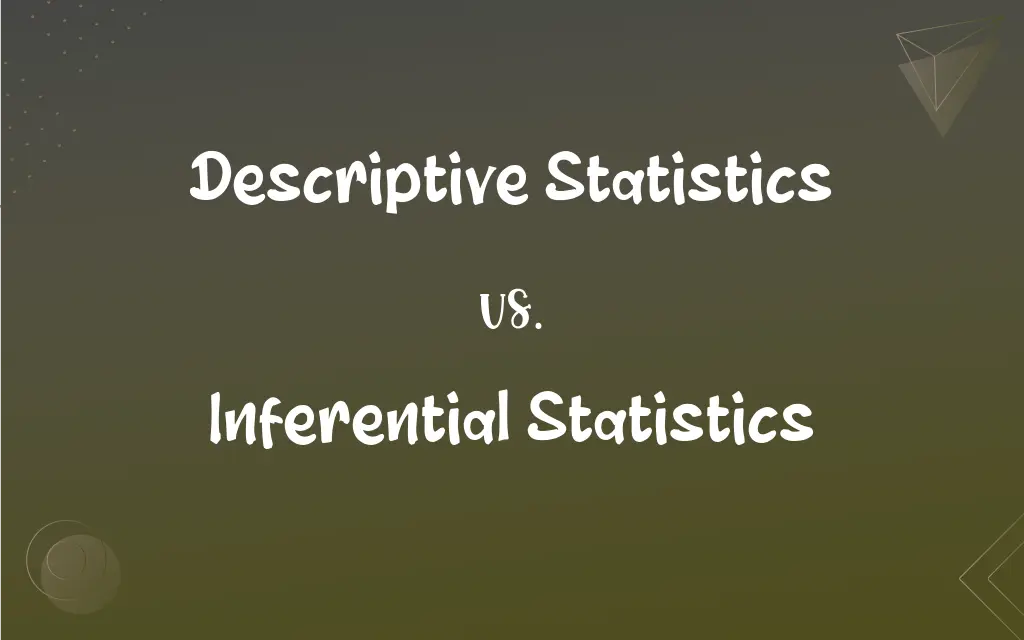Descriptive Statistics vs. Inferential Statistics: What's the Difference?
Edited by Aimie Carlson || By Harlon Moss || Updated on October 15, 2023
Descriptive statistics summarize and organize data, while inferential statistics make predictions or inferences about a population based on sample data.

Key Differences
Descriptive statistics provide a summary of the main aspects of the data, offering a snapshot of its main characteristics. They are used to describe the basic features of data in a study, such as mean, median, mode, and range. Inferential statistics, on the other hand, use sample data to make inferences or predictions about a population or larger dataset.
Descriptive statistics are typically straightforward and simple to compute. They provide a foundation for understanding a dataset's distribution, central tendency, and spread. Inferential statistics take a step further by making predictions or decisions about a population based on the properties of a sample.
Descriptive statistics are most commonly used when the total set of data is available. They allow for clear and concise understanding of data by breaking it down into simpler summaries. Inferential statistics are used when one wants to draw conclusions about a larger group from a smaller sample set.
Descriptive statistics focus primarily on describing, presenting, and interpreting a given set of data in its entirety. Inferential statistics, conversely, focus on drawing conclusions, making predictions, and testing hypotheses about populations based on samples.
Comparison Chart
Purpose
Summarize and organize data
Make predictions or inferences based on sample data
ADVERTISEMENT
Data Used
Entire dataset
Sample data
Main Techniques
Measures of central tendency, dispersion, etc.
Hypothesis testing, confidence intervals, etc.
Outcome
Summary of data characteristics
Predictions, decisions about populations
Dependency
Doesn't depend on probability theory
Relies heavily on probability theory
Descriptive Statistics and Inferential Statistics Definitions
Descriptive Statistics
Methods that provide insight into specific characteristics of data.
By employing descriptive statistics, the researcher identified outliers in the dataset.
ADVERTISEMENT
Inferential Statistics
Procedures that allow conclusions about larger datasets from samples.
Inferential statistics showed a likely increase in future market demand.
Descriptive Statistics
Techniques used to describe and summarize data.
She used descriptive statistics to provide a general overview of the test scores.
Inferential Statistics
Techniques to make predictions about a population based on sample data.
She used inferential statistics to estimate the average income of city residents.
Descriptive Statistics
The process of organizing data into meaningful patterns.
Using descriptive statistics, he found that sales peaked during summer months.
Inferential Statistics
Techniques to derive conclusions from data subject to random variation.
The study used inferential statistics to determine the correlation between variables.
Descriptive Statistics
Tools that help in determining the distribution and tendencies in datasets.
Descriptive statistics showed the majority of students scored above 70%.
Inferential Statistics
Tools that use probability to make generalizations.
Through inferential statistics, it was deduced that the treatment was effective for 90% of the population.
Descriptive Statistics
Quantitative summaries of features within a dataset.
The report began with descriptive statistics outlining the demographic breakdown.
Inferential Statistics
Methods used to test hypotheses and make estimations.
With inferential statistics, he concluded that the drug had a significant effect.
FAQs
How do inferential statistics differ?
Inferential statistics make predictions or inferences about larger populations based on sample data.
What type of data do inferential statistics typically work with?
Inferential statistics work with sample data to draw conclusions about a larger population.
Can descriptive statistics provide predictions?
No, descriptive statistics only describe and summarize data without making predictions.
What's a common tool in descriptive statistics?
Measures of central tendency, like mean, median, and mode, are common in descriptive statistics.
What is the main purpose of descriptive statistics?
Descriptive statistics aim to summarize and organize data.
Can descriptive statistics be used on a sample?
Yes, descriptive statistics can be applied to both samples and entire datasets.
Are histograms used in descriptive statistics?
Yes, histograms are used in descriptive statistics to show data distributions.
Can inferential statistics confirm causal relationships?
While they can suggest relationships, inferential statistics can't confirm causality without controlled experiments.
Are bar charts a tool in descriptive statistics?
Yes, bar charts are a graphical method used in descriptive statistics to visualize data distribution.
What's an example of a descriptive statistic?
Calculating the average age of a group is an example of a descriptive statistic.
What's a common outcome of inferential statistics?
Common outcomes include hypothesis testing results, confidence intervals, and predictions.
Can inferential statistics determine the likelihood of an event?
Yes, inferential statistics often estimate probabilities or likelihoods of events.
How are descriptive statistics presented?
They can be presented numerically or graphically, like in tables or charts.
Are inferential statistics based on probability?
Yes, inferential statistics heavily rely on probability theory to make predictions and test hypotheses.
Do descriptive statistics involve complex calculations?
Typically, they involve straightforward calculations, like averages or percentages.
Which type of statistics provides more detailed data insight?
While descriptive statistics provide a basic data summary, inferential statistics delve deeper into data patterns and relationships.
What's a foundational concept in inferential statistics?
The concept of a "population" and a "sample" is foundational in inferential statistics.
Do inferential statistics require assumptions?
Often, yes. Inferential statistical tests usually have underlying assumptions that need to be met for valid results.
Do inferential statistics always guarantee accurate predictions?
No, predictions from inferential statistics come with a degree of uncertainty and are based on probabilities.
When are inferential statistics most commonly used?
Inferential statistics are used when one wants to generalize findings from a sample to a larger population.
About Author
Written by
Harlon MossHarlon is a seasoned quality moderator and accomplished content writer for Difference Wiki. An alumnus of the prestigious University of California, he earned his degree in Computer Science. Leveraging his academic background, Harlon brings a meticulous and informed perspective to his work, ensuring content accuracy and excellence.
Edited by
Aimie CarlsonAimie Carlson, holding a master's degree in English literature, is a fervent English language enthusiast. She lends her writing talents to Difference Wiki, a prominent website that specializes in comparisons, offering readers insightful analyses that both captivate and inform.































































